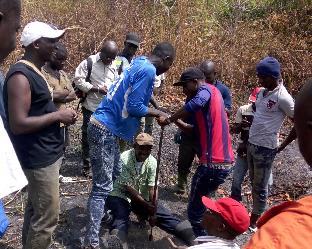
Innovation can be sophisticated and flashy, like a new interactive app for diamond valuation or a portable mechanized washplant that extracts diamonds more efficiently. USAID-funded Property Rights and Artisanal Diamond Development (PRADD II) is currently rolling out both of these innovations in Côte d’Ivoire. However, the project is also finding that getting to the basics of how to dig a better hole, and how to fill them in, may be even more transformational.
“Let’s talk about the humble auger,” said PRADD II director Mark Freudenberger this August at a USAID brown bag on innovative technologies. The hand-held auger, brought to Côte d’Ivoire by the U.S. Geological Survey for testing a simplified method of generating deposit models from bore hole data, makes small bore holes down to 15 feet and requires only two people. As part of a training on improved mining techniques conducted in February by a PRADD II specialist from the Central African Republic (CAR), augers were introduced as a way to determine how deep and how wide diamond-bearing gravel layers are located.
“The auger saves us weeks and sometimes months of work,” said Adama Dosso, a cooperative technician trained by PRADD II from the village of Massala Assolo. Before, teams of miners would have to dig a deep pit to test a site, or just take their chance on mining out a full pit, which costs time and money and may yield poor results. In addition, when these sites are not filled back in, such methods prove to be detrimental to the environment and unsafe for the surrounding communities. Indeed, earlier this year, a child fell in an abandoned pit and died.
Using the auger to determine the depth and direction of gravel provides a more informed approach to site selection. Diggers can also apply the improved mining technique of “terracing”: diggers backfill pits as they systematically remove the diamond-bearing gravel. In Côte d’Ivoire, where mining has gone on for decades leaving behind dangerous holes and destroyed land, using the augers and the terracing sytem could have an enormous positive impact.
“The miners were surprised when they saw how much gravel came from what they thought was a depleted site,” said Sylvain Kouassi, a government agent who provides technical assistance to miners. The reason is that traditional mining consists of haphazard holes over a broad area, with lots of unrecovered gravel between the holes. The terracing techniques applied to old sites allow the villagers to recover remaining gravel while also restoring the land for agriculture and removing dangerous holes.
Since being trained, 30 cooperatives completed demonstration sites in each of their villages, and are planning campaigns to convince and even require diggers—most of whom are migrant workers—use the new techniques of using augers and backfilling pits. What is particularly surprising, however, is that the cooperatives see the techniques as an opportunity to get a better price and change the way they benefit from mining. “In Côte d’Ivoire, communities have historically not mined themselves, but have instead taxed outside diggers,” explained Terah DeJong, PRADD II Côte d’Ivoire Country Director. “They are called cooperatives, but they have rarely invested in mining itself.” The reason is that the haphazard and poor techniques make it an extremely risky activity. Diggers have financial backers who take on the risks and costs, but this also means the backers pass along that cost to diggers in the form of poor prices.
From surveys and statistical analyses, PRADD II estimates that a typical digger earns less than 15% of the initial sales price and less than 5% of the export value. Nearly all diggers are financed by buyers, and they are obligated to sell to them. Villagers have historically preferred to tax instead, as this is more stable. “We are now waking up,” said Adama Dosso, the cooperative focal point. Convinced that the new techniques decrease the risk, many are now starting to mine and dig themselves.
Thanks to the PRADD II training and some equipment support to the cooperatives, the augers have opened the possibility of self-financing by the cooperatives and thereby getting the full sales price of the stones without the 150% to 1000% markup by the buyers. As such, the humble auger and the simple terracing techniques could have a transformational impact on mining and miners, increasing earnings and also rehabilitating the earth.
“It’s not all about apps and tablets,” reminded Mark Freudenberger. “Sometimes simple improvements are the most innovative and have the most impact.”

